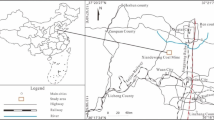Abstract
Mining subsidence destroys environment seriously and is difficult to forecast because the parameters in prediction model are difficult to obtain. As there are many uncertainties in mining subsidence, we forecast it by grey prediction model. Traditional GM (1,1) model predict for a time series. In this paper, the panel data are studied and are viewed as a sequence in which elements are matrix based on cross-sectional data, and the mean sequence of row vector GM (1,1) model, mean sequence of column vector GM (1,1) model and the cell volume sequence GM (1,1) model are established, respectively. Combining these grey models, we build prediction model of cross-sectional data matrix sequence. Thus, the scope of grey prediction has been expanded, and grey forecasting theory has been enriched. Using the newly built predictive models, we study the land deformation due to mining of Pingdingshan coal mine in Henan Province. Practical verification and model accuracy test show that the grey model can make accurate predictions, with a good agreement between the predictive value and actual value. It can provide effective and accurate information and also can provide an important reference for the reclamation planning of surface environment.





Similar content being viewed by others
References
Abidin HZ, Djaja R, Darmawan D, Hadi S, Akbar A, Rajiyowiryono H (2001) Land subsidence of Jakarta (Indonesia) and its geodetic monitoring system. Nat Hazards 23:365–387
Cui J, Dang YG, Liu SF (2009) Novel grey forecasting model and its modeling mechanism. Control Decis 24(11):1702–1706
Cui J, Dang YG, Liu SF (2010) Study on morbidity of NGM (1,1, k) model based on conditions of matrix. Control Decis 25(07):1050–1054
Deng JL (1997) The foundation of grey system theory. J Grey Syst 9(1):40
Deng JL (2001) Negative power AGO in grey theory. J Grey Syst 13(3):3–11
Hao YH, Wang XM (2000) Period residual modification of GM (1,1) modeling. J Grey Syst 12(3):181–183
He XJ, Sun GZ (2001) A non-equigap grey model NGM (1,1). J Grey Syst 13(1):189–192
Hsieh CH (2001) Grey date fitting model and its application to image coding. J Grey Syst 13(1):18–23
Hsieh C-S, Shih T-Y, Hu J-C, Tung H, Huang M-H, Angelier J (2011) Using differential SAR interferometry to map land subsidence: a case study in the Pingtung Plain of SW Taiwan. Nat Hazards 58:1311–1332
Huang Y, Jiang XM (2010) Field-observed phenomena of seismic liquefaction and subsidence during the 2008 Wenchuan earthquake in China. Nat Hazards 54:839–850
Julio Miranda P, Ortíz Rodríguez AJ, Palacio Aponte AG, López Doncel R, Barboza Gudiño R (2012) Damage assessment associated with land subsidence in the San Luis Potosi-Soledad de Graciano Sanchez metropolitan area, Mexico, elements for risk management. Nat Hazards 64:751–765
Kung CY, Chang CP (2004) Application of grey prediction model on China automobile industry. J Grey Syst 16(2):147–154
Liu SF, Lin Y (2011) Grey systems theory and applications. Springer, Berlin, pp 1–28
Wang ZX, Dang YG, Pei LL (2011) Modeling approach for oscillatory sequences based on GM (1,1) power model. Syst Eng Electron 33(11):2440–2444
Wang ZX, Dang YG, Liu SF (2012) Non-equidistant GM (1,1) power model and its application in engineering. Eng Sci 07:98–102
Williams S, Bock Y, Pang P (1998) Integrated satellite interferometry: Tropospheric noise, GPS estimates and implications for interferometric synthetic aperture radar products. Geophysics 103(11):27051–27067
Wu ZP, Liu SF, Dang YG, Mi CM, Xie NM, Cui LH (2011) Study on the morbidity problem in grey model. Syst Eng Theory Pract 31(01):108–112
Xie NM, Zheng J, Xin JH (2012) Novel generalized grey incidence model based on interval grey numbers. Trans Nanjing Univ Aeronaut Astronaut 29(02):118–124
Xiong PP, Dang YG, Shu H (2012) Research on characteristics of MGM (1, m) model. Control Decis 27(03):389–398
Xu YS, Shen SL, Cai ZY, Zhou GY (2008) The state of land subsidence and prediction approaches due to groundwater withdrawal in China. Nat Hazards 45:123–135
Yao TX, Liu SF, Xie NM (2010) Study on the properties of new information discrete GM (1,1) model. J Syst Eng 25(02):164–170
Zeng B, Liu SF, Xie NM, Cui J (2010) Prediction model for interval grey number based on grey band and grey layer. Control Decis 25(10):1585–1592
Zeng B, Liu SF, Meng W (2011) Prediction model of discrete grey number based on kernels and areas. Control Decis 26(09):1421–1424
Zeng B, Liu SF, Meng W, Chen JM (2012) Prediction model of discrete grey number with subjective valued orientation and its application. Control Decis 27(09):1359–1364
Zhang K, Liu SF (2010) Extended clusters of grey incidences for panel data and its application. Syst Eng Theory Pract 30(07):1253–1259
Zhu CY, Xie NM (2010) Research on properties of non-homogenous discrete grey model and its predictive results NDGM. Syst Eng Electron 32(09):1915–1918
Acknowledgments
The authors are grateful to editors and anonymous referees for their very valuable comments and suggestions, which have significantly helped improving the quality of this paper. Meanwhile, this paper is supported by National Natural Science Funds of China (No. 70971064 and U1204701), Project of Henan Province Higher Educational Science and Technology Program (2011A11002), and Scientific and Technological Development Planning Project of Henan Province of China (112400450212).
Author information
Authors and Affiliations
Corresponding author
Rights and permissions
About this article
Cite this article
Xu, H., Liu, B. & Fang, Z. New grey prediction model and its application in forecasting land subsidence in coal mine. Nat Hazards 71, 1181–1194 (2014). https://doi.org/10.1007/s11069-013-0656-4
Received:
Accepted:
Published:
Issue Date:
DOI: https://doi.org/10.1007/s11069-013-0656-4




